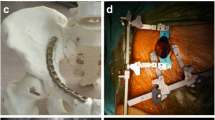Abstract
Purpose
The goal of this study was to evaluate the safety and efficacy of a new technique for posterior column fixation through the standard ilioinguinal approach.
Methods
We conducted a retrospective review involving 33 consecutive patients with complex acetabular fractures treated using a short buttress plate fixation of posterior column through single ilioinguinal approach. Radiographic evaluation was performed using criteria described by Matta. Functional outcome was assessed using modified Postel Merle D’Aubigné score.
Results
Between 2008 and 2013, 33 adult patients with mean age of 46 years and mean follow up of 37.5 months were enrolled. Anatomic reduction was obtained in 61 % of cases, imperfect reduction in 24 % of cases and poor reduction in 15 % of cases. The average modified Merle d’Aubigné score was 15: categorized as excellent in seven, good in 18, fair in three, and poor in four. One patient died at 15 days because of pulmonary embolism. Four patients sustained temporary lateral femoral cutaneous palsy. At final follow up, two patients had severe post-traumatic arthritis; one of them underwent a total hip arthroplasty at 93 months. None of the patients had loss of reduction.
Conclusions
A short buttress plate fixation of posterior column through single ilioinguinal approach for complex acetabular fractures is a safe and effective method.



Similar content being viewed by others
References
Letournel E, Judet R, Elson RA (1993) Introduction: History and Development of Our Methods of Classification and Treatment of Acetabular Fractures. Fract Acetabulum 1–15
Shazar N, Brumback RJ, Novak VP et al (1998) Biomechanical evaluation of transverse acetabular fracture fixation. Clin Orthop Relat Res 7(352):215–222
Abid A, Qureshi MD, Michael T et al (2004) Infrapectineal plating for acetabular fractures: a technical adjunct to internal fixation. J Orthop Trauma 18(3):175–178
Laflamme GY, Hebert-Davies J, Rouleau D et al (2011) Internal fixation of osteopenic acetabular fractures involving the quadrilateral plate. Injury 42(10):1130–1134
Archdeacon MT, Nr K, Collinge C et al (2013) Treatment of protrusio fractures of the acetabulum in patients 70 years and older. J Orthop Trauma 27(5):256–261
Mears DC (1999) Surgical treatment of acetabular fractures in elderly patients with osteoporotic bone. J Am Acad Orthop Surg 7(2):128–141
Tosounidis TH, Gudipati S, Panteli M et al (2015) The use of buttress plates in the management of acetabular fractures with quadrilateral plate involvement: is it still a valid option? Int Orthop 39(11):2219–2226
Peter RE (2015) Open reduction and internal fixation of osteoporotic acetabular fractures through the ilio-inguinal approach: use of buttress plates to control medial displacement of the quadrilateral surface. Injury 46(1):s2–s7
Abo-Elsoud M, Radwan YA, Gobba M, Sadek F (2014) Short-segment fixation through a limited ilioinguinal approach for treating anterior acetabular fractures:a historical-control study. Int Orthop 38(7):1469–1475
Hagen JE, Brian M et al (2015) Anterior intrapelvic modification to the ilioinguinal approach. J Orthop Trauma 29(2):s10–s13
Archdeacon MT (2015) Comparison of the ilioinguinal approach and the anterior intrapelvic approaches for open reduction and internal fixation of the acetabulum. J Orthop Trauma 29(2):s6–s9
Kistler BJ, Sagi C (2015) Reduction of the posterior column in displaced acetabulum fractures through the anterior intrapelvic approach. J Orthop Trauma 29(2):s14–s19
Judet R, Judet J, Letournel E (1964) Fractures of the acetabulum: classification and surgical approaches for open reduction. J Bone Joint Surg 46(12):1615–1675
Moed BR, WillsonCarr SE, Watson JT (2002) Results of operative treatment of fractures of the posterior wall of the acetabulum. J Bone Joint Surg Am 84(5):752–758
Matta JM (2006) Operative treatment of acetabular fractures through the ilioinguinal approach: a 10-year perspective. J Orthop Trauma 20(1):s20–s29
Lawrence KJ (1957) Radiological assessment of osteoarthrosis. Ann Rheum Dis 16(4):494–502
Author information
Authors and Affiliations
Corresponding author
Ethics declarations
Conflict of interest
Each author certifies that he has no commercial or any other associations that might pose a conflict of interest in connection with the submitted article.
Rights and permissions
About this article
Cite this article
Zhuang, Y., Zhang, K., Wang, H. et al. A short buttress plate fixation of posterior column through single ilioinguinal approach for complex acetabular fractures. International Orthopaedics (SICOT) 41, 165–171 (2017). https://doi.org/10.1007/s00264-016-3225-0
Received:
Accepted:
Published:
Issue Date:
DOI: https://doi.org/10.1007/s00264-016-3225-0




